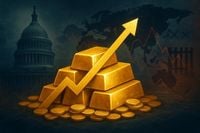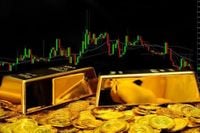Gold has once again seized the spotlight in global financial markets, surging to unprecedented heights as investors and institutions alike flock to the yellow metal amid a maelstrom of economic and political uncertainty. As of early October 2025, gold is trading near $3,900 per ounce—a monumental leap representing nearly a 48% gain since the start of the year, according to reporting from Market Minute and Discovery Alert. This historic rally not only shatters previous records but also signals a profound shift in market psychology and asset allocation strategies worldwide.
The immediate catalyst for gold’s meteoric rise is a confluence of crises that have rattled investor confidence. The United States, the world’s largest economy, finds itself gripped by a federal government shutdown that began on October 1, 2025. Now in its second day, the shutdown is estimated to cost the U.S. economy roughly $7 billion per week and could shave 0.1 to 0.2 percentage points off GDP growth for each week it drags on. With hundreds of thousands of federal workers facing furloughs and crucial economic data releases delayed, the resulting uncertainty has sent shockwaves through financial markets.
Layered atop the fiscal paralysis in Washington are new and escalating trade tensions. The U.S. has imposed a fresh wave of sectoral tariffs targeting heavy trucks, furniture, kitchen cabinets, and pharmaceutical products, alongside Section 232 tariffs on timber and lumber. In a tit-for-tat response, the European Union has announced plans to double tariffs on steel imports to 50%, matching U.S. rates. These measures have disrupted supply chains, pushed up business costs, and injected further anxiety into an already jittery global economy.
According to Discovery Alert, these developments have combined to create “a paradigm shift in gold market psychology, with private capital flows amplifying moves once driven primarily by central banks and macro funds.” The scale of private investor inflows into gold-backed Exchange Traded Funds (ETFs) has exceeded historical projections, with digital investment platforms lowering the barriers to entry and enabling a broader swath of individuals to participate. Retail platforms are reporting record demand for gold products, from small denomination coins to fractional ETF shares.
Goldman Sachs, long bullish on gold, has updated its forecasts to reflect these new realities. The bank now projects gold prices to reach $4,000 per ounce by mid-2026 and $4,300 per ounce by year’s end. However, what’s truly remarkable is their acknowledgment of “significant upside risk”—with the potential for prices to approach or even surpass $5,000 per ounce should just 1% of privately held U.S. Treasury securities be reallocated into gold. Given the sheer size of the Treasury market compared to the much smaller, more illiquid gold market, even modest shifts in asset allocation could unleash a tidal wave of demand, easily overwhelming current supply.
Central banks, too, remain steadfast in their appetite for gold. After a typical summer lull, they have resumed robust buying in autumn 2025, further anchoring the multi-year uptrend in bullion prices. For many emerging market economies, this is a strategic move to diversify reserves away from the U.S. dollar and hedge against geopolitical risk. As Discovery Alert notes, “central banks are again accelerating purchases, adding a stabilizing layer of base demand regardless of private investor sentiment.”
But the story doesn’t end with institutional and sovereign actors. The broader macroeconomic landscape in 2025 is reinforcing gold’s appeal as both a safe haven and an inflation hedge. The U.S. Federal Reserve has pivoted to an interest-rate cutting cycle, making non-yielding assets like gold more attractive. The U.S. dollar is weakening against other major currencies, further enhancing gold’s allure for international investors. Meanwhile, persistent inflationary pressures and lingering doubts about global economic growth have kept anxiety high and risk appetite low.
Market Minute underscores the scale of the current "flight to safety," noting "significant inflows into gold-backed ETFs and a steady increase in central bank gold reserves." The rally is not just a reaction to short-term events but a reflection of deeper concerns about U.S. fiscal policy, political gridlock, and the broader stability of the global economy. For many, gold’s surge is a barometer of profound global stress, echoing historical episodes like the oil crises of the 1970s and the 2008 financial meltdown.
The implications for the corporate sector are equally stark. Gold mining companies such as Barrick Gold, Newmont Corporation, and Agnico Eagle Mines are poised to reap substantial rewards from higher prices, translating into fatter profit margins and expanded exploration budgets. Precious metals streaming and royalty firms like Franco-Nevada and Wheaton Precious Metals will also see revenues swell as the value of their entitlements rises. On the flip side, sectors sensitive to trade disruptions and economic instability—such as manufacturing, logistics, and discretionary retail—face mounting headwinds as tariffs drive up costs and consumer confidence falters.
Interestingly, the current environment is also broadening the definition of “safe haven.” While gold remains the undisputed leader, cryptocurrencies like Bitcoin are increasingly being viewed as credible hedges against systemic risk. This trend suggests a long-term shift in defensive investment strategies, with investors seeking diversification beyond traditional assets.
For portfolio managers and individual investors, the menu of gold investment vehicles has never been richer. Options range from physical gold and gold-backed ETFs to mining equities, futures, and even fractional digital gold offerings. Each comes with its own set of risks and rewards, but all benefit from the underlying surge in demand and price.
Yet, as with any rally, risks abound. Discovery Alert warns that a sudden hawkish turn by central banks, stronger-than-expected economic data, or a rapid resolution of geopolitical tensions could spark profit-taking or even a sharp correction in gold prices. Market volatility, especially at major psychological thresholds like $4,000 per ounce, could also trigger turbulence. Still, with the fundamental drivers firmly in place, many analysts see any dips as potential buying opportunities for long-term holders.
The broader mining sector is already feeling the effects of high gold prices. Projects once deemed marginal are now economically viable, exploration budgets are expanding, and the potential for industry consolidation is rising. At the same time, governments and regulators may revisit tax and royalty regimes as profits swell, underscoring the need for ongoing due diligence.
Looking ahead, the path for gold will be shaped by the resolution of the U.S. government shutdown, the trajectory of global trade disputes, and the response of central banks to persistent inflation and economic stress. A swift political resolution could trigger a temporary pullback, while prolonged uncertainty may propel gold to even loftier heights. Either way, the events of 2025 have decisively reinforced gold’s status as the ultimate safe haven—and perhaps, as the bellwether of a new economic era.


